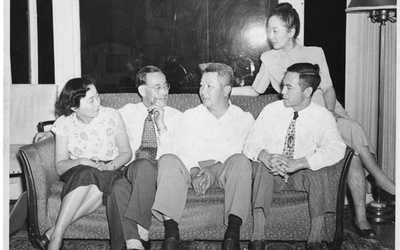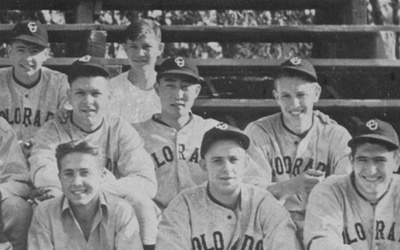Enduring Communities

Enduring Communities: The Japanese American Experience in Arizona, Colorado, New Mexico, Texas, and Utah is an ambitious three-year project dedicated to re-examining an often-neglected chapter in U.S. history and connecting it with current issues of today. These articles stem from that project and detail the Japanese American experiences from different perspectives.
Stories from this series
No Invisible Minority: Japanese Americans at the University of Colorado, 1910-1945 - Part 4
May 30, 2014 • David M. Hays
Read Part 3 >> Furthermore, on July 6, 1943, the instructors collectively signed a JLS faculty resolution thanking President Stearns and Captain Frank H. Roberts, USN for their efforts on behalf of the instructors and their families. The Silver & Gold also ran several editorials critical of the Denver Post’s hostile campaign against “Americans of Japanese Ancestry” or AJAS. In these editorials, student editorialists depicted EO 9066 as high handed, of doubtful legality, and as a poor portrayal of American …
No Invisible Minority: Japanese Americans at the University of Colorado, 1910-1945 - Part 3
May 23, 2014 • David M. Hays
Read Part 2 >> World War II furthered diversity in the university’s faculty roster, which came to include 165 Japanese American sensei among the 179 recorded instructors of the U.S. Navy Japanese/Oriental Language School. Aside from Japanese American sensei, Japanese American names began or continued to appear in the directories between 1942 and 1945. Japanese American wives of sensei found other work at the labor-short, wartime university. Among those who worked at the Boulder campus were: Mabel Inouye (chemistry, 1943); Ike …
No Invisible Minority: Japanese Americans at the University of Colorado, 1910-1945 - Part 2
May 16, 2014 • David M. Hays
Read Part 1 >>Professor Eckhardt brought Boothroyd's plan to the December 8, 1938, meeting of the Faculty Senate. To have described the faculty's response as unenthusiastic would have been an overstatement. The faculty's initial apprehension and skepticism may have had less to do with the question of segregation and more to do with the students' risky plan to address it. Many of the professors might have guessed that the student body would not answer as Boothroyd and his classmates anticipated. A vote …
No Invisible Minority: Japanese Americans at the University of Colorado, 1910-1945 - Part 1
May 9, 2014 • David M. Hays
Japanese and Japanese American students attended the University of Colorado in very small numbers in the 40 years before World War II. By the late 1930s Japanese American students were attending at an average of 20 students per semester out of a total student population of just under 4,000. As such a small portion of the overall student body, one might anticipate that Japanese Americans would have been an invisible minority; but that would be far from the case. Japanese …
Japanese Americans in the Interior West: A Regional Perspective on the Enduring Nikkei Historical Experience in Arizona, Colorado, New Mexico, Texas, and Utah (and Beyond): Part 6
Nov. 20, 2009 • Arthur A. Hansen
>> Part 5 This essay has thus far examined how scholars from varying disciplines have, in recent years, supported a deeper exploration of the Interior West Nikkei experience from pioneering days through World War II. Let us now briefly explore recent scholarship pertaining to the post-World War II experience of Interior West Nikkei. A strategic starting point is a 2006 study done by Joel Tadao Miyasaki.1 The larger and direct concern of Miyasaki—who describes himself as “the son of a …
Japanese Americans in the Interior West: A Regional Perspective on the Enduring Nikkei Historical Experience in Arizona, Colorado, New Mexico, Texas, and Utah (and Beyond): Part 5
Nov. 13, 2009 • Arthur A. Hansen
>> Part 4 The Japanese Arizona World War II experience has been assayed by two historians, both working at Arizona universities: Charles Ynfante at Northern Arizona University and Andrew Russell at Arizona State University. Their work on this topic has in common the fact that both consider it within the context of Arizona’s overall home-front experience during World War II.1 Russell’s article in Arizona Goes to War: The Home Front and the Front Lines during World War II , …



























